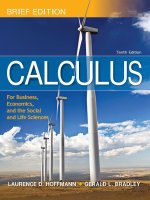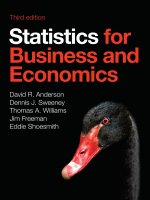Statistics for business economics 7th by paul newbold chapter 06
Bạn đang xem bản rút gọn của tài liệu. Xem và tải ngay bản đầy đủ của tài liệu tại đây (852.92 KB, 49 trang )
Statistics for
Business and Economics
7th Edition
Chapter 6
Sampling and
Sampling Distributions
Copyright © 2010 Pearson Education, Inc. Publishing as Prentice Hall
Ch. 6-1
Chapter Goals
After completing this chapter, you should be able to:
Describe a simple random sample and why sampling is important
Explain the difference between descriptive and inferential statistics
Define the concept of a sampling distribution
Determine the mean and standard deviation for the sampling distribution of the sample mean,
Describe the Central Limit Theorem and its importance
Determine the mean and standard deviation for the sampling distribution of the sample
proportion,
Describe sampling distributions of sample variances
X
pˆ
Copyright © 2010 Pearson Education, Inc. Publishing as Prentice Hall
Ch. 6-2
6.1
Tools of Business Statistics
Descriptive statistics
Collecting, presenting, and describing data
Inferential statistics
Drawing conclusions and/or making decisions
concerning a population based only on
sample data
Copyright © 2010 Pearson Education, Inc. Publishing as Prentice Hall
Ch. 6-3
Populations and Samples
A Population is the set of all items or individuals of interest
Examples:
All likely voters in the next election
All parts produced today
All sales receipts for November
A Sample is a subset of the population
Examples:
1000 voters selected at random for interview
A few parts selected for destructive testing
Random receipts selected for audit
Copyright © 2010 Pearson Education, Inc. Publishing as Prentice Hall
Ch. 6-4
Population vs. Sample
Population
a b
Sample
cd
b
ef gh i jk l m n
o p q rs t u v w
x y
z
Copyright © 2010 Pearson Education, Inc. Publishing as Prentice Hall
c
gi
o
n
r
u
y
Ch. 6-5
Why Sample?
Less time consuming than a census
Less costly to administer than a census
It is possible to obtain statistical results of a sufficiently high precision based on samples.
Copyright © 2010 Pearson Education, Inc. Publishing as Prentice Hall
Ch. 6-6
Simple Random Samples
Every object in the population has an equal chance of being selected
Objects are selected independently
Samples can be obtained from a table of random numbers or computer random number
generators
A simple random sample is the ideal against which other sample methods are compared
Copyright © 2010 Pearson Education, Inc. Publishing as Prentice Hall
Ch. 6-7
Inferential Statistics
Making statements about a population by examining sample results
Sample statistics
(known)
Population parameters
Inference
(unknown, but can
be estimated from
sample evidence)
Sample
Copyright © 2010 Pearson Education, Inc. Publishing as Prentice Hall
Population
Ch. 6-8
Inferential Statistics
Drawing conclusions and/or making decisions
concerning a population based on sample results.
Estimation
e.g., Estimate the population mean weight
using the sample mean weight
Hypothesis Testing
e.g., Use sample evidence to test the claim
that the population mean weight is 120
pounds
Copyright © 2010 Pearson Education, Inc. Publishing as Prentice Hall
Ch. 6-9
6.2
Sampling Distributions
A sampling distribution is a distribution of all of the possible values of a
statistic for a given size sample selected from a population
Copyright © 2010 Pearson Education, Inc. Publishing as Prentice Hall
Ch. 6-10
Chapter Outline
Sampling
Distributions
Sampling
Distribution of
Sample
Mean
Sampling
Distribution of
Sample
Proportion
Copyright © 2010 Pearson Education, Inc. Publishing as Prentice Hall
Sampling
Distribution of
Sample
Variance
Ch. 6-11
Sampling Distributions of
Sample Means
Sampling
Distributions
Sampling
Distribution of
Sample
Mean
Sampling
Distribution of
Sample
Proportion
Copyright © 2010 Pearson Education, Inc. Publishing as Prentice Hall
Sampling
Distribution of
Sample
Variance
Ch. 6-12
Developing a
Sampling Distribution
Assume there is a population …
Population size N=4
Random variable, X,
A
B
C
D
is age of individuals
Values of X:
18, 20, 22, 24 (years)
Copyright © 2010 Pearson Education, Inc. Publishing as Prentice Hall
Ch. 6-13
Developing a
Sampling Distribution
(continued)
Summary Measures for the Population Distribution:
X
∑
μ=
P(x)
i
N
18 + 20 + 22 + 24
=
= 21
4
σ=
∑ (X − μ)
i
N
.25
0
2
= 2.236
18
20
22
24
A
B
C
D
x
Uniform Distribution
Copyright © 2010 Pearson Education, Inc. Publishing as Prentice Hall
Ch. 6-14
Developing a
Sampling Distribution
(continued)
Now consider all possible samples of size n = 2
16 Sample
Means
1st 2nd Observation
Obs 18 20 22 24
18 18 19 20 21
20 19 20 21 22
16 possible samples
(sampling with
replacement)
Copyright © 2010 Pearson Education, Inc. Publishing as Prentice Hall
22 20 21 22 23
24 21 22 23 24
Ch. 6-15
Developing a
Sampling Distribution
(continued)
Sampling Distribution of All Sample Means
Sample Means
Distribution
16 Sample Means
1st 2nd Observation
Obs 18 20 22 24
18 18 19 20 21
20 19 20 21 22
22 20 21 22 23
24 21 22 23 24
Copyright © 2010 Pearson Education, Inc. Publishing as Prentice Hall
_
P(X)
.3
.2
.1
0
18 19
20 21 22 23
(no longer uniform)
24
_
X
Ch. 6-16
Developing a
Sampling Distribution
(continued)
Summary Measures of this Sampling Distribution:
X
∑
E(X) =
N
σX =
=
i
18 + 19 + 21+ + 24
=
= 21 = μ
16
2
(
X
−
μ)
i
∑
N
(18 - 21)2 + (19 - 21)2 + + (24 - 21)2
= 1.58
16
Copyright © 2010 Pearson Education, Inc. Publishing as Prentice Hall
Ch. 6-17
Comparing the Population with its
Sampling Distribution
Population
N=4
μ = 21
Sample Means Distribution
n=2
μX = 21
σ = 2.236
σ X = 1.58
_
P(X)
.3
P(X)
.3
.2
.2
.1
.1
0
0
18
20
22
24
A
B
C
D
Copyright © 2010 Pearson Education, Inc. Publishing as Prentice Hall
X
18 19
20 21 22 23
24
_
X
Ch. 6-18
Expected Value of Sample Mean
Let X1, X2, . . . Xn represent a random sample from a population
The sample mean value of these observations is defined as
1 n
X = ∑ Xi
n i=1
Copyright © 2010 Pearson Education, Inc. Publishing as Prentice Hall
Ch. 6-19
Standard Error of the Mean
Different samples of the same size from the same population will yield different sample means
A measure of the variability in the mean from sample to sample is given by the Standard Error
of the Mean:
σ
σX =
n
Note that the standard error of the mean decreases as the sample size increases
Copyright © 2010 Pearson Education, Inc. Publishing as Prentice Hall
Ch. 6-20
If sample values are
not independent
(continued)
If the sample size n is not a small fraction of the population size N, then individual sample
members are not distributed independently of one another
Thus, observations are not selected independently
A correction is made to account for this:
or
σ2 N − n
Var( X) =
n N −1
Copyright © 2010 Pearson Education, Inc. Publishing as Prentice Hall
σ
σX =
n
N−n
N −1
Ch. 6-21
If the Population is Normal
If a population is normal with mean μ and standard deviation σ, the sampling distribution of
is
also normally distributed with
X
and
σ
σX =
n
If the sample size n is not large relative to the population size N, then
μX = μ
and
μX = μ
Copyright © 2010 Pearson Education, Inc. Publishing as Prentice Hall
σ N−n
σX =
n N −1
Ch. 6-22
Z-value for Sampling Distribution
of the Mean
Z-value for the sampling distribution of
:
X
( X − μ)
Z=
σX
where:
X
μ
σx
= sample mean
= population mean
= standard error of the mean
Copyright © 2010 Pearson Education, Inc. Publishing as Prentice Hall
Ch. 6-23
Sampling Distribution Properties
Normal Population
Distribution
μx = μ
(i.e.
is unbiased )
x
μ
x
μx
x
Normal Sampling
Distribution
(has the same mean)
Copyright © 2010 Pearson Education, Inc. Publishing as Prentice Hall
Ch. 6-24
Sampling Distribution Properties
(continued)
For sampling with replacement:
As n increases,
Larger
sample size
decreases
σx
Smaller
sample size
μ
Copyright © 2010 Pearson Education, Inc. Publishing as Prentice Hall
x
Ch. 6-25









